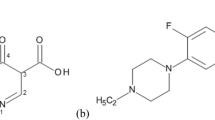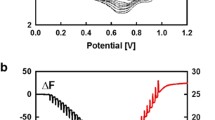Abstract
While high living organisms use sounds and words to communicate with each other, bacteria provide this function with some communication molecules. These communication molecules are expressed as “Quorum Sensing” (QS) or chemicals produced by the environment sensing system and used by bacteria to communicate. This case revealed that bacteria are talking. N-acyl-homoserine-lactones (AHL), which are the main signaling molecules of gram-negative bacteria, may express the pathogenic factors, and Quorum Sensing (QS) system may play an important role in the identification of the being virus. AHLs are produced at low concentrations that are difficult to detect with general techniques. In this study, molecularly imprinted polymeric membranes, which are specific to lactone with 6-carbons (C6-HSL) were prepared on QCM chips, and molecularly imprinted QCM chips were utilized to detect N-hexanoyl-L-homoserine lactone (C6-HSL) with high sensitivity from the aqueous medium. Characterization of the synthesized polymers were analyzed by AFM, SEM, contact angle and FTIR-ATR spectrophotometer analyzes. The maximum C6-HSL adsorption on the C6-HSL imprinted QCM chip surface was observed at 1000 ng/mL concentration, pH 7.0. Moreover, GC–MS results correlated with the results of our studies, and they confirmed the sensitivity of synthesized polymers toward C6-HSL in solution containing competitor molecules.






Similar content being viewed by others

References
Turan NB, Chormey DS, Büyükpınar Ç et al (2017) Quorum sensing: Little talks for an effective bacterial coordination. TrAC Trends Anal Chem 91:1–11. https://doi.org/10.1016/j.trac.2017.03.007
Acet Ö, Erdönmez D, Acet BÖ, Odabaşı M (2021) N-acyl homoserine lactone molecules assisted quorum sensing: effects consequences and monitoring of bacteria talking in real life. Arch Microbiol 203(7):3739–3749
Schauder S, Bassler BL (2001) The languages of bacteria. Genes Dev 15:1468–1480. https://doi.org/10.1101/gad.899601
Galloway WRJD, Hodgkinson JT, Bowden SD et al (2011) Quorum sensing in gram-negative bacteria: small-molecule modulation of AHL and AI-2 quorum sensing pathways. Chem Rev 111:28–67. https://doi.org/10.1021/cr100109t
Jiang H, Jiang D, Shao J, Sun X (2016) Magnetic molecularly imprinted polymer nanoparticles based electrochemical sensor for the measurement of Gram-negative bacterial quorum signaling molecules (N-acyl-homoserine-lactones). Biosens Bioelectron 75:411–419. https://doi.org/10.1016/j.bios.2015.07.045
Cataldi TRI, Bianco G, Palazzo L, Quaranta V (2007) Occurrence of N-acyl-l-homoserine lactones in extracts of some gram-negative bacteria evaluated by gas chromatography–mass spectrometry. Anal Biochem 361:226–235. https://doi.org/10.1016/j.ab.2006.11.037
Kim Y-W, Sung C, Lee S et al (2015) MALDI-MS-based quantitative analysis for ketone containing homoserine lactones in pseudomonas aeruginosa. Anal Chem 87:858–863. https://doi.org/10.1021/ac5039362
Middleton B, Rodgers HC, Cámara M et al (2002) Direct detection of N-acylhomoserine lactones in cystic fibrosis sputum. FEMS Microbiol Lett 207:1–7. https://doi.org/10.1111/j.1574-6968.2002.tb11019.x
Purohit AA, Johansen JA, Hansen H et al (2013) Presence of acyl-homoserine lactones in 57 members of the vibrionaceae family. J Appl Microbiol 115:835–847. https://doi.org/10.1111/jam.12264
Chen JY, Penn LS, Xi J (2018) Quartz crystal microbalance: sensing cell-substrate adhesion and beyond. Biosens Bioelectron 99:593–602
Jandas PJ, Prabakaran K, Luo J, MG DH, (2021) Effective utilization of quartz crystal microbalance as a tool for biosensing applications. Sensors Actuators A Phys 331:113020
Na Songkhla S, Nakamoto T (2021) Overview of quartz crystal microbalance behavior analysis and measurement. Chemosensors 9:350
Lim HJ, Saha T, Tey BT et al (2020) Quartz crystal microbalance-based biosensors as rapid diagnostic devices for infectious diseases. Biosens Bioelectron 168:112513
Haupt K, Mosbach K (2000) Molecularly Imprinted polymers and Their Use in biomimetic sensors. Chem Rev 100:2495–2504. https://doi.org/10.1021/cr990099w
Romero M, Acuna L, Otero A (2012) Patents on quorum quenching: interfering with bacterial communication as a strategy to fight infections. Recent Pat Biotechnol 6:2–12. https://doi.org/10.2174/187220812799789208
Golkar Z, Bagasra O, Pace DG (2014) Bacteriophage therapy: a potential solution for the antibiotic resistance crisis. J Infect Dev Ctries 8:129–136. https://doi.org/10.3855/jidc.3573
Garcia Lopez J, Piletska EV, Whitcombe MJ et al (2019) Application of molecularly imprinted polymer nanoparticles for degradation of the bacterial autoinducer N -hexanoyl homoserine lactone. Chem Commun 55:2664–2667. https://doi.org/10.1039/C8CC07685E
Tajani AS, Soheili V, Moosavi F et al (2022) Ultra selective and high-capacity dummy template molecular imprinted polymer to control quorum sensing and biofilm formation of Pseudomonas aeruginosa. Anal Chim Acta 1199:339574
Adeniyi OK, Ngqinambi A, Mashazi PN (2020) Ultrasensitive detection of anti-p53 autoantibodies based on nanomagnetic capture and separation with fluorescent sensing nanobioprobe for signal amplification. Biosens Bioelectron 170:112640. https://doi.org/10.1016/j.bios.2020.112640
Önal B, Acet Ö, Sanz R et al (2019) Co-evaluation of interaction parameters of genomic and plasmid DNA for a new chromatographic medium. Int J Biol Macromol 141:1183–1190. https://doi.org/10.1016/j.ijbiomac.2019.09.068
Acet Ö, Aksoy NH, Erdönmez D, Odabaşı M (2018) Determination of some adsorption and kinetic parameters of α-amylase onto Cu+2-PHEMA beads embedded column. Artif Cells, Nanomedicine Biotechnol 46:S538–S545. https://doi.org/10.1080/21691401.2018.1501378
Wu H, Shi C, Zhu Q et al (2021) Capillary-driven blood separation and in-situ electrochemical detection based on 3D conductive gradient hollow fiber membrane. Biosens Bioelectron 171:112722. https://doi.org/10.1016/j.bios.2020.112722
Mozammal Hossain MD, Moon J-M, Gurudatt NG et al (2019) Separation detection of hemoglobin and glycated hemoglobin fractions in blood using the electrochemical microfluidic channel with a conductive polymer composite sensor. Biosens Bioelectron 142:111515. https://doi.org/10.1016/j.bios.2019.111515
Noma SAA, Ulu A, Acet Ö et al (2020) Comparative study of ASNase immobilization on tannic acid-modified magnetic Fe 3 O 4 /SBA-15 nanoparticles to enhance stability and reusability. New J Chem 44:4440–4451. https://doi.org/10.1039/D0NJ00127A
Gurbuz F, Akpınar Ş, Ozcan S et al (2019) Reducing arsenic and groundwater contaminants down to safe level for drinking purposes via Fe3+-attached hybrid column. Environ Monit Assess 191:722. https://doi.org/10.1007/s10661-019-7862-9
Baran NY, Acet Ö, Odabaşı M (2017) Efficient adsorption of hemoglobin from aqueous solutions by hybrid monolithic cryogel column. Mater Sci Eng C 73:15–20. https://doi.org/10.1016/j.msec.2016.12.036
Yavuz H, Odabaşi M, Akgöl S, Denizli A (2005) Immobilized metal affinity beads for ferritin adsorption. J Biomater Sci Polym Ed. https://doi.org/10.1163/1568562053783713
Cömert ŞC, Özgür E, Uzun L, Odabaşı M (2022) The creation of selective imprinted cavities on quartz crystal microbalance electrode for the detection of melamine in milk sample. Food Chem 372:131254
Ansari S, Masoum S (2019) Molecularly imprinted polymers for capturing and sensing proteins: current progress and future implications. TrAC Trends Anal Chem 114:29–47
Anantha-Iyengar G, Shanmugasundaram K, Nallal M et al (2019) Functionalized conjugated polymers for sensing and molecular imprinting applications. Prog Polym Sci 88:1–129
BelBruno JJ (2018) Molecularly imprinted polymers. Chem Rev 119:94–119
Piletsky S, Canfarotta F, Poma A et al (2020) Molecularly imprinted polymers for cell recognition. Trends Biotechnol 38:368–387
Scheller FW, Zhang X, Yarman A et al (2019) Molecularly imprinted polymer-based electrochemical sensors for biopolymers. Curr Opin Electrochem 14:53–59. https://doi.org/10.1016/j.coelec.2018.12.005
Odabaşı M, Uzun L, Baydemir G et al (2018) Cholesterol imprinted composite membranes for selective cholesterol recognition from intestinal mimicking solution. Coll Surf B Biointerfaces 163:266–274. https://doi.org/10.1016/j.colsurfb.2017.12.033
Odabaşi M, Say R, Denizli A (2007) Molecular imprinted particles for lysozyme purification. Mater Sci Eng C 27:90–99. https://doi.org/10.1016/j.msec.2006.03.002
Yola ML, Uzun L, Özaltın N, Denizli A (2014) Development of molecular imprinted nanosensor for determination of tobramycin in pharmaceuticals and foods. Talanta 120:318–324
Serinbaş A, Önal B, Acet Ö et al (2020) A new application of inorganic sorbent for biomolecules: IMAC practice of Fe3+-nano flowers for DNA separation. Mater Sci Eng C 113:111020. https://doi.org/10.1016/j.msec.2020.111020
Acknowledgements
This work was supported by The Scientific and Technological Research Council of Turkey (Grant Number:119Z184) and Aksaray University Scientific Research Projects Coordination, (Grant Number:2018/060). Authors gratefully acknowledge the use of the services and facilities of Scientific and Technological Application and Research Center of Aksaray University (ASUBTAM).
Author information
Authors and Affiliations
Corresponding author
Additional information
Publisher's Note
Springer Nature remains neutral with regard to jurisdictional claims in published maps and institutional affiliations.
Supplementary Information
Below is the link to the electronic supplementary material.
Rights and permissions
About this article
Cite this article
Acet, Ö., Odabaşı, M. Detection of N-hexanoyl-L-homoserine lactone via MIP-based QCM sensor: preparation and characterization. Polym. Bull. 80, 6657–6674 (2023). https://doi.org/10.1007/s00289-022-04377-x
Received:
Revised:
Accepted:
Published:
Issue Date:
DOI: https://doi.org/10.1007/s00289-022-04377-x



